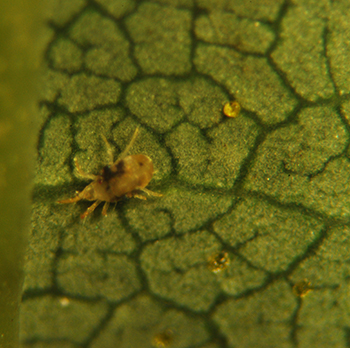Michigan hop update – July 31, 2014
Two-spotted spider mite populations are high and growers should carefully monitor for this pest that can affect cone quality and act as a contaminate pest at harvest. Potato leafhopper and downy mildew continue to be observed.

Growing degree day accumulation (GDD) is significantly different along the western portion of the state with the weather drying out for most areas. As of July 31, the Benton Harbor Enviro-weather station has accumulated 1,505 GDD50 with 0.19 inches of rain over the past week; the Clarksville Enviro-weather station has recorded 1,359 GDD50 and 0.13 inches of rain; the Bear Lake Enviro-weather station has accumulated 1,181 GDD50 and 0.03 inches of rain; and the Northwest Michigan Horticultural Research Center accumulated 1,199 GDD50 with just over 0.5 inches of rain this past week. Cones and burrs are visible on many varieties around the state with growers reportedly cutting nitrogen rates at this stage.
Some hopyards are exhibiting yellow, chlorotic leaves on the bottom 2-5 inches of bines that may be associated with higher than optimal soil pH levels limiting nutrient availability for the plant. Growers with soils at a pH level above 7.4 and bines that are exhibiting these symptoms may consider adjusting soil pH after harvest or in the spring to correct for this. Soil pH greatly affects the solubility of nutrients with the availability of most nutrients being increased in more acid soils. If soil pH is not an issue, growers should consider a nutrient deficiency in general.
As the weather has dried out across the state, growers should remain vigilant in scouting for two-spotted spider mites. Populations are increasing steadily and have reached very high levels in some hopyards with a significant number of eggs present and causing concern as harvest approaches for some growers. Two-spotted spider mites are a significant pest of hops in Michigan and can cause complete economic crop loss when high numbers occur by decreasing the photosynthetic ability of the leaves and causing direct mechanical damage to the hop cones. Two-spotted spider mites feed on the liquid in plant cells, eventually causing visible symptoms. Leaves take on a bronzed and white appearance and can defoliate under high pressure conditions. Intense infestations weaken the plant and reduce yield and quality. Infested cones develop a reddish discoloration, do not hold up to the drying process, and commonly have lower alpha levels and shorter storage potential. Additionally, the mites themselves act as a contaminate issue for brewers.
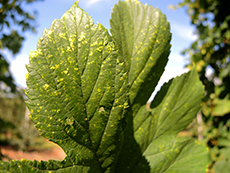
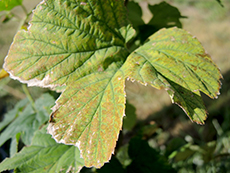
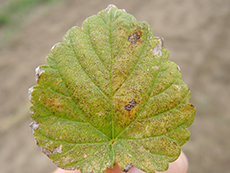
Left, Early symptoms of two-spotted spider mite damage on hop. Middle, Advanced symptoms of damage. Right, Damage on young hop leaves from nursery plants. Photo credit: Erin Lizotte, MSU Extension
Two-spotted spider mites thrive under hot conditions with the pace of development increasing until an upper threshold around 100 degrees Fahrenheit is reached. Conversely, cold and wet weather is not conducive to development. . Two-spotted spider mites are very small, but can be observed on the underside of leaves using a hand lens. They may be hard to see even using a hand lens, and growers are encouraged to look for movement to help them locate the mites. The eggs look like tiny, clear spheres and are most commonly found in close proximity to adults, cast skins and larvae. The larvae themselves are small, translucent versions of the adults that begin the season with a distinctly orange hue which changes over to translucent, yellow or green as they feed. Adults also have two dark spots.
When you are observing the underside of leaves, keep an eye out for beneficial, predatory mites that actually feed on two-spotted spider mites. Predatory mites are often translucent, larger than two-spotted spider mites and move at a much faster speed across the leaf surface. Predatory mites play an important role in balancing the two-spotted spider mite population and should be protected when possible.
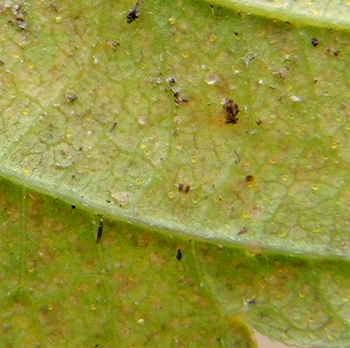
Left, Underside of hop leaf with a dusty appearance caused by two-spotted spider mites, a large adult mite is also visible. Right, Magnified image of an adult two-spotted spider mite. Photo credits: Erin Lizotte, MSU Extension
Growers should be scouting for mites season long and keep in mind that only when mites reach an economically significant level should cultural and chemical intervention be considered. Use a hand lens to evaluate two leaves from 20 plants per yard. Thresholds developed in the Pacific Northwest have established that more than two adult mites per leaf in June indicate the need to implement a pest management strategy. By mid-July, the threshold increases to five to 10 mites per leaf. Remember that if cones are not infested, hop plants can tolerate a good deal of damage from mites. Removal of the lowest 3 feet of foliage may help prevent mites from readily moving up into the canopy.
Growers needing to treat for mites at this time are encouraged to avoid applying pyrethroids insecticides which are hard on beneficial mites and have been shown to flare pest mite populations. Products containing abamectin, bifenezate, dicofol, spirodiclofen, fenpyroximate, hexythiazox, sulfur and etoxazole have varying levels of activity. For a complete list of registered products with these active ingredients, refer to the Michigan State University Extension publication, “Pesticides registered for use on hops in Michigan,” and always read the label. Be sure to carefully note the pre-harvest interval if growers are approaching harvest.
Growers should carefully monitor their hops for potato leafhopper populations as significant numbers continue to be observed. Potato leafhopper adults and nymphs (wingless immatures) move in all directions when disturbed, unlike some leafhoppers that have a distinct pattern of movement. Some very small nymphs are actually clear, but have the characteristic shape of the adults when viewed using a hand lens. The nymphs and adults may also appear bright yellow-green in color.
Potato leafhoppers can’t survive Michigan’s winter and survive in the Gulf States until adults migrate north in the spring on storm systems. There is no set economic threshold for potato leafhoppers in hops; however, some hopyards are seeing significant damage at this time. Although hop plants are susceptible to potato leafhoppers, they can tolerate some level of feeding and growers should be conservative in the application of insecticides. Potato leafhopper feeding causes what growers have termed “hopper burn,” a necrosis of the leaf margin in a v-shaped pattern giving leaves a yellowed or stunted appearance. Growers can agitate the bines and look for adults to take flight as a quick spot check, but should confirm their presence and prevalence by flipping leaves over and looking for adults and wingless nymphs on the underside of leaves.
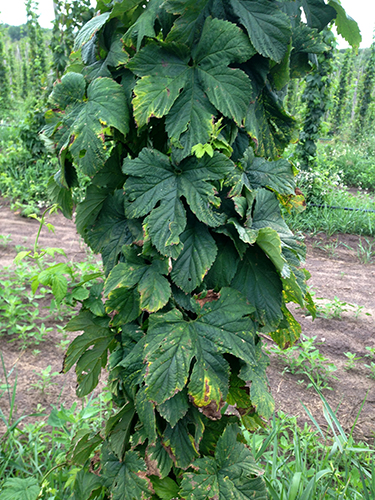
Trained bines with leaves showing necrotic symptoms of “hopper burn” along the margins.
Growers needing to treat for potato leafhoppers can utilize products containing neonicitinoids (imidacloprid or thiamethoxam), pyrethroids (bifenthrin or beta-cyfluthrin), which may increase pest mite populations, organophosphates (malathion) or spinosyns (spinosad). Organic growers can utilize spinosad labeled as Entrust or pyrethrin labeled as Pyganic, both of which are OMRI-approved products for potato leafhopper management. For a complete list of registered products, see “Pesticides registered for use on hops in Michigan” and always read the label. Growers with quickly approaching harvest dates should also carefully consider the pre-harvest interval.
Most growers are seeing Japanese beetle adult activity subsiding. Japanese beetle adults are considered a generalist pest that affects many crops found on or near grassy areas, particularly irrigated turf. Japanese beetle grubs feed on grass roots in early spring and again in the fall and can cause significant damage to turf. They prefer moist soil conditions and do not survive prolonged periods of drought.
Adult Japanese beetles emerge in early July and feed on hundreds of different plant species. Adult beetles feed on the top surface of leaves skeletonizing the tissue. If populations are high, they can remove all of the green leaf material from between the veins on entire plants.
Japanese beetle adults are a substantial insect and measure 0.375 to 0.5 inches long. The thorax is green and wing covers are copper colored. There are five tufts of white hairs on both sides of the abdomen and a pair of tufts on the end of the abdomen that can help distinguish Japanese beetles from other look-alike species. The legs and head are black. Visual observation of adults or feeding damage is an effective scouting technique. Growers should scout along a transect through hopyards at least weekly until detection. Because of their aggregating behavior, they tend to be found in larger groups and are relatively easy to spot. Pheromone and floral baited traps are available and can help indicate the arrival of adults and estimate the potential pest pressure but are not considered effective for trapping out Japanese beetles. Growers considering the traps should remember that they may attract Japanese beetle adults from the surrounding area and contribute to damage.
There are no established treatment thresholds or data on how much Japanese beetle damage hops can sustain. Well-established and vigorous bines will likely not require 100 percent protection, but younger bines with limited leaf area will need to be managed more aggressively. Also, if flowers burrs are present and being fed on heavily growers should consider management.
Managing Japanese beetles can be a frustrating endeavor as they often re-infest from surrounding areas, especially during peak adult emergence in July. This re-infestation is often misinterpreted as an insecticide failure, but efficacy trials have shown that a number of insecticides remain effective treatment options. Malathion is effective, but can take up to three days to take effect and provides 10-14 days of residual control. Pyrethroids (bifenthrin or beta-cyfluthrin) have good knockdown activity, and seven to 10 days of residual control, but can be problematic in hopyards where mites are a concern. Pyrethroid use has been shown to flare spider mite populations, killing predatory mites which help keep pest mite populations in check. Neonicitonoids (imidacloprid or thiamethoxam) have contact toxicity for two to five days, and then a longer residual period of plant protection during which they act as an anti-feedant.
OMRI-approved organic options include neem-based products (azadirachtin), which have a one- to two-day residual and good knockdown activity, as well as Surround (kaolin clay), which has had good results in blueberries and grapes and acts as a physical barrier and irritant. For a complete list of registered products, see “Pesticides registered for use on hops in Michigan” and always read the label.
Growers should continue to scout for and protect against downy mildew. Downy mildew management should begin as the first basal spike emerge and continue through harvest if necessary. Growers should be proactive in applying protectant early sprays as basal spikes emerged in the spring and continue to keep tissue covered with protectant fungicide applications every 10-21 days depending on product and weather. Downy mildew is caused by Pseudoperonospora humuli and can cause significant yield and quality losses, depending on variety and when infection becomes established. In extreme cases, cones can become infected and the crown may die.
Typically, downy mildew infections appear early in the season on the emerging basal spikes. Spikes then appear stunted, brittle and distorted. Infected leaves have angular water soaked lesions that follow leaf venation. Eventually, the water-soaked lesions turn brown and necrotic with fuzzy and gray-black asexual spore masses developing on the underside of infected leaf lesions. As bines continue to expand, new tissue becomes infected and fails to climb the string. Growers can attempt to retrain new shoots, but often incur yield loss as a result. At this time the most prevalent symptom of downy mildew is stunted side arm growth and dieback. We are also seeing downy mildew infections of cones in some areas.
The causal agent of downy mildew overwinters in dormant buds or crowns, moving into buds during early spring and then into the tissue of the basal spikes as shoots expand. The pathogen produces copious spores on the underside of infected leaves. According to “A Field Guide for IPM in Hops,” infection is favored by mild to warm temperatures of 60 to 70 degrees Fahrenheit when free moisture is present for at least 1.5 hours, although leaf infection can occur at temperatures as low as 41 F when wetness persists for 24 hours or longer.
It takes a multipronged approach to manage for downy mildew. Growers should utilize a protectant fungicide management strategy to mitigate the risks of early and severe infections. Keep in mind that varieties vary widely in their susceptibility to downy mildew and select the more tolerant varieties when possible. Clean planting materials should also be selected when establishing new hopyards since this disease is readily spread via nursery stock. It is also recommended that growers pull all basal foliage during spring pruning. All pruning materials should be removed from the hopyard and covered up or burned to reduce inoculum.
Cultural practices alone are not enough to manage downy mildew. Well timed fungicide applications just after the first spikes emerge and before pruning have been shown to significantly improve infection levels season long. Subsequent fungicide applications should be made season long and in response to conducive environmental conditions (temperatures above 41 F and wetting events). Protectant fungicide strategies are particularly important during the year of planting to minimize crown infection and limit disease levels in the future. Fungicides containing copper, boscalid, pyraclostrobin, phosphorous acids, and a number of biopesticides have varying activity against downy mildew.
For organic growers, OMRI-approved copper formulations are the most effective. Washington State University has documented resistance in the downy mildew pathogen, Pseudoperonospora humuli, to fosetyl-Al, the active ingredient in Aliette. Based on these findings, growers are cautioned from relying on Aliette for downy mildew management. Aliette is not compatible with copper. For a complete list of fungicides labeled for the control of downy mildew on hops, see “Pesticides registered for use on hops in Michigan.”
If you already have downy mildew established in your hopyard, cultural practices will be very important in regaining ground as the season progresses. According to Oregon State University, diseased shoots on the string should be removed by hand and healthy shoots retrained in their place. Remove superfluous basal foliage and lower leaves to promote air movement in the canopy and to reduce the duration of wetting periods. If there is a cover crop, it should be mowed close to the ground. If yards have no cover crop, cultivation can help dry the soil and minimize humidity. Keep nitrogen applications moderate.
It is important that growers do not mistake downy mildew for powdery mildew as the effective pesticide classes are completely different. Powdery mildew has not been confirmed in Michigan and is caused by Podosphaera macularis, a completely different pathogen than what causes downy mildew. If you think you have powdery mildew in your hopyard please contact Erin Lizotte at taylo548@msu.edu.



 Print
Print Email
Email